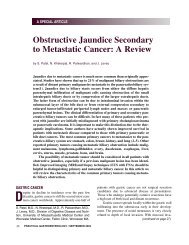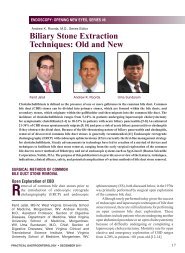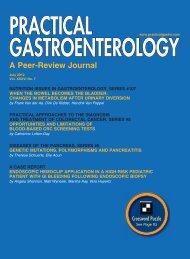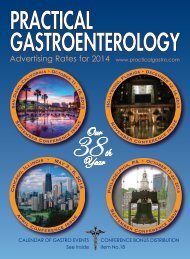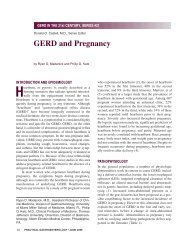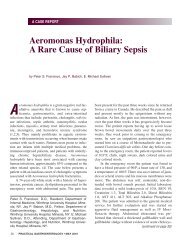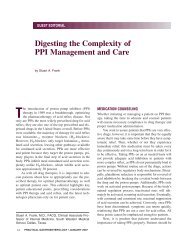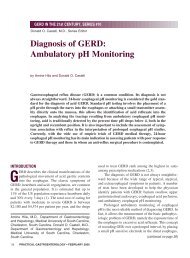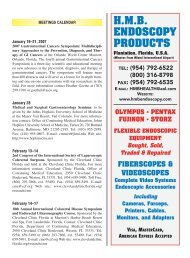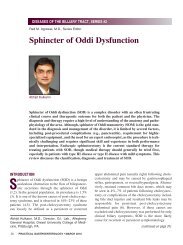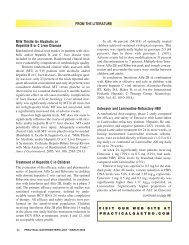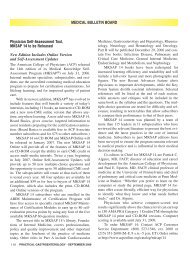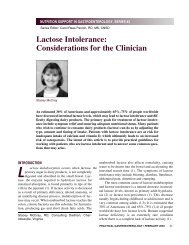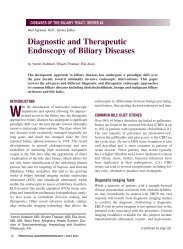Eosinophilic Esophagitis - Practical Gastroenterology
Eosinophilic Esophagitis - Practical Gastroenterology
Eosinophilic Esophagitis - Practical Gastroenterology
You also want an ePaper? Increase the reach of your titles
YUMPU automatically turns print PDFs into web optimized ePapers that Google loves.
<strong>Eosinophilic</strong> <strong>Esophagitis</strong><br />
GERD IN THE 21ST CENTURY, SERIES #14<br />
rences after short treatment periods we have tended to<br />
taper the dose from 2 puffs bid to 1 puff bid after 6<br />
months then 1 puff daily for a while. There is no<br />
proven best way.<br />
Systemic corticosteroids have been used with success,<br />
usually in resistant patients; however, long term<br />
use is not advised due to potential side effects including<br />
stunted growth in children and candidiasis.<br />
Other treatments include disodium cromoglycate,<br />
a mast cell stabilizer, and leukotriene inhibitors such as<br />
montelukast. We have seen one patient who was<br />
unable to take inhaled steroids who took oral disodium<br />
cromoglycate. She has remained asymptomatic for<br />
several months and her esophageal eosinophilia is<br />
gone. There are rare patients who must be placed on<br />
immunomodulators such as azathioprine. Straumann<br />
has rarely had to treat chronic patients with EE with<br />
azathioprine alone (Straumann A., personal communication).<br />
A pilot study has been conducted with<br />
mepolizumab, a humanized monoclonal antibody<br />
against IL-5 which suggests improvement in the<br />
degree of eosinophilia in the tissue but these results<br />
need to be further investigated (16).<br />
TREATMENT (ESOPHAGEAL DILATION)<br />
Straumann first described the “crepe paper” mucosa as<br />
fragile with loss of elasticity thought to be pathognomonic<br />
for EE, causing large lacerations after passing<br />
the endoscope despite a lack of narrowing or resistance<br />
(17).<br />
Langdon suggested dilation for strictures from EE<br />
should be done cautiously because of the risk of tear<br />
and perforation due to the delicate nature of the<br />
mucosa and recommended inspection of the esophagus<br />
after each dilator has been passed (18).<br />
Kaplan, et al recommended a minimum of 8 weeks<br />
of medical therapy with proton pump inhibitors, histamine<br />
antagonists, or immunosuppresants before<br />
attempting dilation as patients with EE are more prone<br />
to developing mucosal rents, even with passage of the<br />
endoscope and perforation after dilation (3). We<br />
encourage careful dilation, waiting several weeks after<br />
steroids have been introduced, if possible. Often the<br />
steroids will render the patient’s dysphagia asymptomatic<br />
and dilation need not be performed.<br />
CONCLUSION<br />
<strong>Eosinophilic</strong> esophagitis is now better recognized by<br />
both gastroenterologists and pathologists. Hopefully<br />
through more expeditious and accurate diagnosis of<br />
this specific disease entity, more information can be<br />
obtained to improve patient care and the relief of their<br />
symptoms with medical therapy and minimizing the<br />
development of strictures. ■<br />
References<br />
1. Morrow JB, Vargo JJ, Goldblum JR, Richter JE. The ringed<br />
esophagus: histological features of GERD. Am J Gastro,<br />
2001;96:984-989.<br />
2. Potter JW, Saeian K, Staff D, et al. <strong>Eosinophilic</strong> esophagitis in<br />
adults: an emerging problem with unique esophageal features.<br />
Gastro Endosc, 2004;59:355-361.<br />
3. Kaplan M, Mutha EA, Jakate, et al. Endoscopy in eosinophilic<br />
esophagitis: “feline” esophagus and perforation risk. Clin Gastroenterol<br />
Hepatol, 2003;1:433-437.<br />
4. Fox VL, Nurko S, Furuta GT. <strong>Eosinophilic</strong> esophagitis: it’s not<br />
just kid’s stuff. Gastro Endosc, 2002;56:260-270.<br />
5. Kelly ML, Frazier JP. Symptomatic midesophageal webs. JAMA,<br />
1966;197:143-146.<br />
6. Landres RT, Juster GG, Strum WB. <strong>Eosinophilic</strong> esophagitis in a<br />
patient with vigorous achalasia. <strong>Gastroenterology</strong>, 1978;<br />
74:1298-301.<br />
7. Attwood SE, Smyrk TC, Demeester TR, et al. Esophageal<br />
eosinophilia with dysphagia. A distinct clinicopathologic syndrome.<br />
Dig Dis Sci, 1993;38(1):109-116.<br />
8. Kelly KJ, Lazenby AJ, Rowe PC, et al. <strong>Eosinophilic</strong> esophagitis<br />
attributed to gastroesophageal reflux: Improvement with an<br />
amino acid-based formula. <strong>Gastroenterology</strong>, 1995;109:1503-<br />
1512.<br />
9. Markowitz JE, Spergel JM, Ruchelli E, et al. Elemental diet is an<br />
effective treatment for eosinophilic esophagitis in children and<br />
adolescents. Am J Gastroenterol, 2003;98:777-782.<br />
10. Mishra A, Rothenberg ME. Intratracheal IL-13 induces<br />
eosinophilic esophagitis by an IL-5, eotaxin-1, and STAT6-<br />
dependent mechanism. <strong>Gastroenterology</strong>, 2003;125:1419-1427.<br />
11. Guajardo JR, Plotnick LM, Fende,JM, et al. Eosinophil-associated<br />
gastrointestinal disorders: A world-wide-web based registry.<br />
J Pediatrics, 2002;141(4):576-581.<br />
12. Fox VL, Nurko S, Furuta GT. <strong>Eosinophilic</strong> esophagitis: it’s not<br />
just kid’s stuff. Gastrointestinal Endoscopy, 2002;56(2):260-270.<br />
13. Nurko S, Teitelbaum JE, Husain K. Association of Schatzki ring<br />
with eosinophilic esophagitis in children. J Pediatr Gastroenterol<br />
Nutr, 2004;38(4):436-441.<br />
14. Liacouras CA, Ruchelli E. <strong>Eosinophilic</strong> esophagitis. Curr Opin<br />
Pediatr, 2004; 16(5):560-566.<br />
15. Arora AS, Perrault J, Smyrk TC. Topical corticosteroid treatment<br />
of dysphagia due to eosinophilic esophagitis in adults. Mayo Clin<br />
Proc, 2003;78:830-835.<br />
16. Garrett JK, Jameson SC, Thomson B, et al. Anti-interleukin 5<br />
(mepolizumab) therapy for hypereosinophilic syndromes.<br />
J Allergy Clin Immunol, 2004;113:115-119.<br />
17. Straumann A, Rossi L, Simon HU, et al. Fragility of the<br />
esophageal mucosa:A pathognomonic endoscopic sign of primary<br />
eosinophilic esophagitis? Gastrointestinal Endoscopy,<br />
2003; 57(3):407-412.<br />
18. Langdon DE. Corrugated ringed and too small esophagi. Am J<br />
Gastroenterol, 1999; 94:542-543.<br />
48<br />
PRACTICAL GASTROENTEROLOGY • SEPTEMBER 2005



